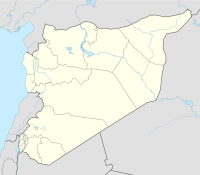Bouqras
| Location | 35 km (22 mi) southeast of Deir ez-Zor, Syria |
|---|---|
| Region | Euphrates |
| Coordinates | 35°05′07″N 40°23′51″E / 35.085274°N 40.397445°E |
| Type | Tell |
| Part of | Village |
| Length | 250 metres (820 ft) |
| Width | 100 metres (330 ft) |
| Area | 5 hectares (540,000 sq ft) |
| History | |
| Material | bones, flints, pottery, plaster |
| Founded | c. 7400 |
| Abandoned | c. 6200 BC |
| Periods | PPNA, PPNB, Neolithic |
| Site notes | |
| Excavation dates | 1960-1965 1976-1978 |
| Archaeologists |
Henri de Contenson Willem J. van Liere Peter Akkermanns Maurits van Loon J. J. Roodenberg H. T. Waterbolk |
| Condition | Ruins |
| Management | Directorate-General of Antiquities and Museums |
| Public access | Yes |
Bouqras is a large, oval shaped, prehistoric, Neolithic Tell, about 5 hectares (540,000 sq ft) in size, located around 35 kilometres (22 mi) from Deir ez-Zor in Syria.
The tell was discovered in 1960 by Dutch Geomorphologist, Willem van Liere. It was excavated between 1960 and 1965 by Henri de Contenson and van Liere and later between 1976 and 1978 by Peter Akkermanns, Maurits van Loon, J. J. Roodenberg and H. T. Waterbolk.
The mound was found to be approximately 4.5 metres (15 ft) deep and showed evidence of 11 periods of occupation spread over at least 1000 years between ca. 7400 and 6200 BC. The earliest levels, 11 to 8, showed early Neolithic aceramic occupation developing on to stages with pottery in levels 7 to 1, from which over 7000 sherds were recovered. Material from later levels was visible on the surface when first discovered. The layout and arrangement of houses seems to have been well ordered with similar arrangements of rooms, entrances, hearths and other features. Houses were made of mud bricks and generally rectangular with three or four rooms.
Bouqras seems to have developed in comparative isolation with few other settlements near the area. Interiors of the buildings featured white plastered walls with occasional use of red ochre for decoration with some images of birds. By later stages of the settlement, it was likely inhabited by as many as 700 to 1000 villagers. Large quantities of obsidian was found suggesting links with Anatolia. A distinctive group of limestone, alabaster and gypsum vessels was also found made from local materials. Rounded or cylindrical beads were also found made of bone, shell, greenstones, carnelian and dentalium. An alabaster bracelet fragment and pendant were recovered as forms of personal decoration. Several stone stamp seals including one of alabaster and one of jadeite were found with incised rectilinear patterns along with a few clay figurines. Pottery started to be found from the third level of habitation including a white plaster vessel. Other materials were varied with course and fine sherds made with mixed straw and sand. Some sherds were burnished or painted red, one with a triangle on it. Arrowheads recovered included Byblos points and two types of Amuq points along with two other distinctive designs. Flints were usually of a fine dark grey or brown type found locally.
...
Wikipedia

